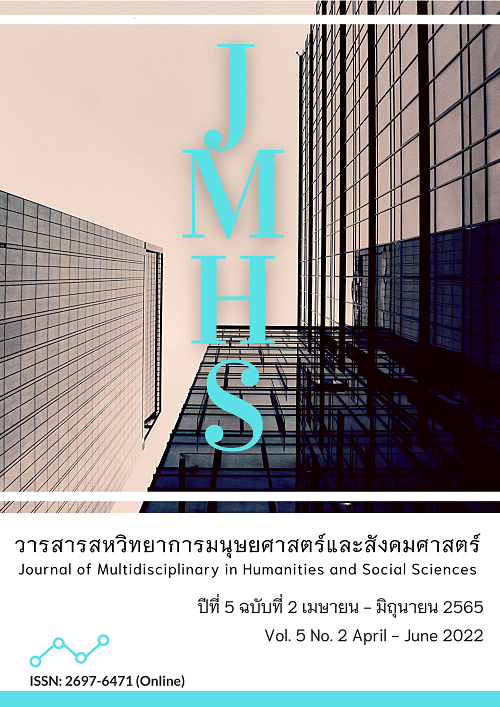A Study of Vipassana Practice in Sona sutta
Main Article Content
Abstract
The objectives of this article were 1) to study the content and important Buddhist teachings found in Sona Sutta and 2) to study the practice of Vipassana meditation in Sona Sutta. All the study data has been taken from Theravada Buddhist scriptures and documents related to them, being summarized, analyzed, and compiled in descriptive type. The results of the research as for the insight practical principle found in Sona Sutra, it was found that 1) In advance insight practice, perseverance is necessarily required, if there is too much persistence, it will be distracted, in opposite if there is too much relentlessness, it will be idle, the constant diligence only will lead the practice for progress and success; 2) In Vipassana meditation practice, the five faculties are necessary as elements composing of faith, persistence, mindfulness, concentration, and wisdom, the insight practitioner must adjust the five faculties to be equal, that is, faith and wisdom to be equal, persistence and concentration but only mindfulness should be followed and implied anywhere and everywhere; and 3) in vipassana meditation, one should determine the six pairs of internal and external senses, namely the first pair of eye with visible objects, the second pair of ears and sound, third pair is nose and smells, fourth pair is tongue and taste, fifth pair is body and touch, sixth pair is mind and mental objects. When there is contact with the eyes, ears, nose, tongue, body, and mind, practitioners must be aware of the rise and fall of the six sensual organs that appear in the present moment and not be fascinated by any thought, then their insight practice will be advanced faster.
Article Details

This work is licensed under a Creative Commons Attribution-NonCommercial-NoDerivatives 4.0 International License.
Views and opinions appearing in the Journal it is the responsibility of the author of the article, and does not constitute the view and responsibility of the editorial team.
References
พระธรรมธีรราชมหามุนี (โชดก ญาณสิทธิ). (2549). โพธิปักขิยธรรม 37 ประการ. (พิมพ์ครั้งที่ 6). นนทบุรี: สัมปชัญญะ.
พระปัญญาวโร ภิกขุ. (2554). หลักการปฏิบัติวิปัสสนาภาวนาเบื้องต้น. (ฉัตรนคร องคสิงห์, แปล). กรุงเทพฯ: โรงพิมพ์มหาจุฬาลงกรณราชวิทยาลัย.
พระพรหมคุณาภรณ์ (ป.อ.ปยุตฺโต). (2557). พจนานุกรมพุทธศาสตร์ ฉบับประมวลธรรม. (พิมพ์ครั้งที่ 27). กรุงเทพฯ: โรงพิมพ์มหาจุฬาลงกรณราชวิทยาลัย.
พระพุทธโฆสเถระ. (2554). คัมภีร์วิสุทธิมรรค. (สมเด็จพระพุฒาจารย์ (อาจ อาสภมหาเถร), แปล). (พิมพ์ครั้งที่ 10). กรุงเทพฯ: ธนาเพรส.
พระมหากิตติณัฏฐ์ สุกิตฺติเมธี. (2564). การวิเคราะห์แนวทางงดเว้นจากความเสื่อมในปราภวสูตร. วารสารสหวิทยาการมนุษยศาสตร์และสังคมศาสตร์, 4(1), 84-95.
พระสมหมาย สมสิทฺโธ. (2564). ศึกษาการปฏิบัติวิปัสสนาภาวนาในอาสีวิโสปมสูตร. วารสาร มจร บาฬีศึกษาพุทธโฆสปริทรรศน์, 7(2), 129-139.
มหาจุฬาลงกรณราชวิทยาลัย. (2552). อรรถกถาภาษาไทย ฉบับมหาวิทยาลัยมหาจุฬาลงกรณราชวิทยาลัย. กรุงเทพฯ: โรงพิมพ์มหาจุฬาลงกรณราชวิทยาลัย.
มหาวิทยาลัยมหาจุฬาลงกรณราชวิทยาลัย. (2539). พระไตรปิฎกภาษาไทย ฉบับมหาจุฬาลงกรณราชวิทยาลัย. พระนครศรีอยุธยา: มหาวิทยาลัยมหาจุฬาลงกรณราชวิทยาลัย.
Damnoen, P. S., & Dhirabhaddo, P. N. (2019). The Development of Indicators of Active Aging Enhancement in Buddhist Way for the Retirement of Elderly. Journal of Graduate MCU Khonkaen Campus, 6(3), 209-228.
Yusamran, P. P., Thitipasitthikorn, P. P., Damnoen, P. S., Thienthong, P. B., Rattana-ngam, S., & Homchan, P. (2021). Conservative and inheritance of Atthami Bucha day for sustainable promotion tourism. Journal of Positive Psychology and Wellbeing, 5(3), 1400–1410.


